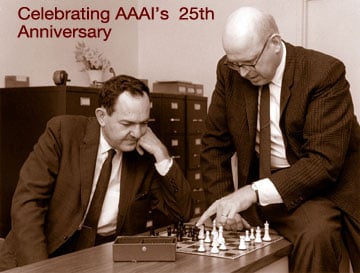4 Facts About The Logic Theorist
- It created better proofs than human mathematicians.
- Its creation birthed fields of study like Artificial Intelligence and heuristic programming.
- Its invention necessitated the creation of the Information Processing Language (IPL).
- The Logic Theorist beat human mathematicians Alfred North Whitehead and Bertrand Russell as it offered better and more detailed proofs of their theorems.
Logic Theorist History
The inspiration for the Logic Theorist was sparked by various moments of pure scientific epiphany between the three collaborators, notably Herbert Simon, Allen Newell, and to a lesser degree Cliff Shaw (more on him below).
The idea for the Logic Theorist was sparked in the early 1950s when Simon was consulting RAND Corporation. He saw a printing machine that printed out maps using ordinary letters, digits, and punctuation as symbols during his time there.
This piqued his mind as he realized that a machine could manipulate symbols and simulate decision-making and possibly attain the level of human thought. That was to be the genesis of automated thinking.
The program that had sparked Simon’s mind had been written by Newell, a RAND Corporation scientist studying logistics and organization theory. Newell was stimulated by a presentation he had watched in 1954 about pattern matching. At that moment, he realized that the interaction of a programmable unit, although simple, could accomplish more complex behavior, which included the intelligent behavior of human beings.

In 1955, Simon and Newell had discussions on the possibility of teaching machines to think. These discussions birthed a program that could prove mathematical theorems like in Alfred North Whitehead and Bertrand Russell’s Principia Mathematica. It was to be specifically engineered to mimic the problem-solving prowess exhibited by real people. The result was to be a program that could think like a proper human mathematician. However, to get the program running, Simon and Newell would need the help of a computer programmer.
To write the codes, Newell enlisted the help of John Clifford Shaw, a computer programmer from RAND, to develop the program. Cliff Shaw wrote the codes for the logic theorist using an early version of IPL (Information Processing Language), a programming language running on a computer of RAND’s Santa Monica research facility. By 1956, the Logic Theorist was finally ready for use. However, the perfect opportunity to really show the invention to the world would present itself in a few months after its making.
When the Logic Theorist was being built, the field of AI did not exist and was just coined by John McCarthy during the summer of 1956 for a conference organized at Dartmouth College in collaboration with Marvin Minsky and Claude Shannon. At the conference, Simon and Newell presented their invention, which was accepted. Later on, Simon confides: “They didn’t want to hear from us, and we sure didn’t want to hear from them: we had something to show them! In a way, it was ironic because we already had done the first example of what they were after; and second, they didn’t pay much attention to it”.
So, while McCarthy and his team were brainstorming the possibility of Artificial Intelligence, Simon, Newell, and Shaw were already recording breakthroughs in the same field.
Logic Theorist: How it worked
The Logic Theorist was built to mimic the brain prowess of human mathematicians, proving mathematical theorems like the ones in Russell and Whitehead’s Principia Mathematica. It proved 38 of the 52 theorems in the second chapter of the book and offered more detailed proofs than Russell and Whitehead.
Logic Theorist: Historical significance
The Logic Theorist remains a breakthrough in the history of science. The Logic Theorist was a pioneering force in Artificial Intelligence, heuristic programming, and computer programming. While computer programming was already existing at the time the invention was made, AI and Heuristic programming were not.
The logic theorist also ventured into the area of the search tree, having the root as the initial hypothesis, with each branch as a deduction based on the rules of logic. The aim of everything was the goal which was found somewhere in the tree. This was the proposition that the program was trying to prove.
The implementation of the Logic Theorist on a computer led to the development of a programming language called the Information Programming Language (IPL). This programming language used the same symbols that McCarthy adopted in creating his programming language, known as the LISP Programming language. This language is still relevant among researchers in the AI Circles.
The breakthrough of the Logic theorist also has significance in the world of philosophy. In Simon’s words, “[We] invented a computer program capable of thinking non-numerically, and thereby solved the venerable mind-body problem, explaining how a system composed of matter can have the properties of mind.” This raised questions about the possibility of machines having minds. This school of thought was later named Strong AI by philosopher John Searle. This argument still rages in various philosophical circles today.
The image featured at the top of this post is ©Paolo Massa, CC BY-SA 2.0, via Wikimedia Commons.
